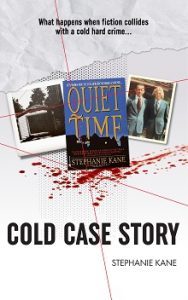A Story in Search of a Shape
 Say you’re sitting on a hot story. Let’s make it a murder. Now raise the stakes and make it a murder you were involved in. What’s the best way to tell it? Far-fetched as it may seem, this premise is the story of the past fifty years of my life.
Say you’re sitting on a hot story. Let’s make it a murder. Now raise the stakes and make it a murder you were involved in. What’s the best way to tell it? Far-fetched as it may seem, this premise is the story of the past fifty years of my life.
Here’s one way to tell it:
In 1973, a college girl is engaged to the boy of her dreams. A week before their wedding, his mom is beaten to death in the family’s garage. The girl is one of the last people to speak to the mom that morning; hours later, she sees the killer. The boy’s dad is arrested, but the charges are dropped and the murder is not discussed. Murder and marriage make the boy and girl grow up. For the nine years they’re married, the girl has the awful feeling that their wedding triggered what happened in the garage. After sitting on the story for thirty years, she goes in search of the best way to tell it.
First she writes it as fiction, in a mystery novel called Quiet Time. In 2001, Bantam publishes it, under a pen name and after she (the writer) makes changes Bantam’s lawyers request so nobody will recognize the real murder. Released the week of 9/11, Quiet Time has a short life and a quick death. But in 2005, after seeing the writer interviewed on a late-night rerun of a canceled public TV show, the killer’s now-elderly sister reads Quiet Time and comes forward with a confession he’d made.
A cold case is opened. Claiming the writer and sister cooked up the confession in order to sell books, the defense subpoenas all of Quiet Time’s drafts and the writer’s correspondence and notes. By then she has published three legal thrillers but, plagued by the threat of more subpoenas and self-doubts over what she’d done to real people to exorcise her own ghosts, for the next eight years she writes nothing.
When the cold case is over, the writer has access to a wealth of material: audiotapes, crime scene photos, thousands of pages of police reports, forensic analyses and transcripts. Unsatisfied with the record, she spends four years researching the case and conducting interviews of her own. She keeps a running log of her discoveries. Now in possession of the facts, she tries to write the story in third-person as true crime, but purged of emotion the story is flat.
At wit’s end, she turns to a blog. In first-person 500-word bites, she re-enters the story and uses witness statements and transcripts to bring the real characters alive. When she finds a theme and an ending to the murdered woman’s story and her own, she turns it into a book called Cold Case Story….
Obviously, there are many ways to tell the story of Betty Frye’s 1973 murder, the journey it sent me on, and the consequences of my telling it.
Quiet Time and Cold Case Story bookend an eight-book, twenty-year writing career, but I’m still the girl I was the day Betty was killed. Which is to say, I never stopped wanting to know what really happened: who killed her and why. If I’d had the facts, I would have written Cold Case Story in 2001 instead of resorting to fiction in Quiet Time. Experimenting with different ways to tell it, time after time I struggled with three things: my role in the murder, my access to facts, and my limitations as a writer. But the glue between these efforts—what makes each a version of the same story—is how the murder affected me.
Quiet Time was my first attempt to exorcise Betty’s murder. Written closest to that time, with limited access to source material and catharsis as my goal, fiction was the only way to make her story come out right. To process the events through the imagined eyes of others, the earliest drafts were in a dozen first-person voices. The Greek chorus was eventually axed, but what survived rang true enough to make the killer’s sister come forward with his confession.
The end of the cold case brought an avalanche of material. To keep track of it, I kept a dated log intended to be my basic research and reference tool. But written in first-person entries as I discovered each new piece, a fresh voice emerged: my own! Now the story acquired a new dimension: not simply my role in Betty’s murder and the cold case, but my mission to uncover facts to understand the event that shaped and consumed such a big part of my life.
True crime came next. Two challenges immediately arose: paring down the mass of details and merging the overlapping narratives (murder and cold case) into one. Writing it in third person—why did I need to be in the story? Quiet Time was my catharsis, after all—also made me queasy about dramatizing events in which I’d played no part. The result was a story which was neither Betty’s nor mine.
Because it was the landing base and dramatic engine, I went back to the log. Now the issue was structure. For one that was more linear, direct and concise, I turned to a first-person blog. Kicking off each post with short quotes from transcripts and interviews gave Betty’s story texture and immediacy without letting the Greek chorus run away with the plot. The tightness also made me see the murder and cold case as distinct narratives, hijacked in 1973 and 2005 by prosecutors and defense lawyers to spin competing stories. Storytelling became the unifying theme.
Cold Case Story is the one I always wanted to tell. To get there, I experimented with voice and ran the gamut of form: fiction to diary/log to true crime to memoir. Each was indispensable. They taught me one story could be told in innumerable ways—but it would always be mine to tell.
—
Stephanie Kane is a lawyer and award-winning author of four crime novels. Born in Brooklyn, she came to Colorado as a freshman at CU. She owned and ran a karate studio in Boulder and is a second-degree black belt. After graduating from law school, she was a corporate partner at a top Denver law firm before becoming a criminal defense attorney. She has lectured on money laundering and white collar crime in Eastern Europe, and given workshops throughout the country on writing technique. She lives in Denver with her husband and two black cats.
Extreme Indifference and Seeds of Doubt won a Colorado Book Award for Mystery and two Colorado Authors League Awards for Genre Fiction. She belongs to Mystery Writers of America, Rocky Mountain Fiction Writers and the Colorado Authors League.
WEBSITE: writerkane.com
COLD CASE STORY BLOG: writerkane.com/blog
FACEBOOK: /AuthorStephanieKane
COLD CASE STORY
 Cold Case Story is about a family fractured along the fault lines of a murder. It’s about kids made to choose sides and aunts who never forgot. It’s about fiction and reality colliding, how one shapes the other and how fiction has real consequences. It’s also a very personal story of what it’s like to ping-pong between participant and observer, novelist and catalyst and witness to your own uneasy set of facts.
Cold Case Story is about a family fractured along the fault lines of a murder. It’s about kids made to choose sides and aunts who never forgot. It’s about fiction and reality colliding, how one shapes the other and how fiction has real consequences. It’s also a very personal story of what it’s like to ping-pong between participant and observer, novelist and catalyst and witness to your own uneasy set of facts.
The past is never dead. It’s not even past.
— William Faulkner, Requiem for a Nun
All are punish’d.
— Shakespeare, Romeo and Juliet
Cold Case Story is based on the brutal murder of a housewife in the Denver suburbs in 1973. A college student back then, Stephanie Kane was more than a witness to this terrible crime. For nearly thirty years, she remained silent. Then, in 2001, she tried to exorcise it by fictionalizing it in a mystery novel called Quiet Time. But instead of laying the murder to rest, Quiet Time brought it roaring back to life.
Cold Case Story is about a family that fractured along the fault lines of a murder. It’s about fiction colliding with a cold hard crime, and the very personal story of how it feels to ping-pong between participant and observer, novelist and witness to one’s own uneasy set of facts. In the end, all are punished—even the guilty.
BUY HERE
Category: Contemporary Women Writers
























